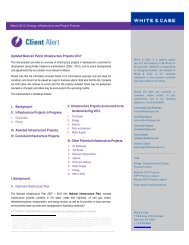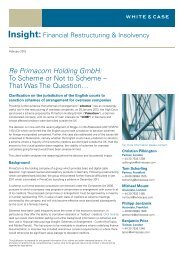Mexican Legal Framework of Business Insolvency - White & Case
Mexican Legal Framework of Business Insolvency - White & Case
Mexican Legal Framework of Business Insolvency - White & Case
Create successful ePaper yourself
Turn your PDF publications into a flip-book with our unique Google optimized e-Paper software.
i. Disposition <strong>of</strong> Assets<br />
During conciliation, the debtor may dispose <strong>of</strong> assets in the ordinary course <strong>of</strong> business,<br />
but will require the conciliator’s consent to dispose <strong>of</strong> assets out <strong>of</strong> the ordinary course<br />
<strong>of</strong> business [LCM 75]. The reader can find further analysis on this subject in Section 32.<br />
j. Avoidance Powers<br />
<strong>Insolvency</strong> proceedings (both liquidation and reorganization) may commence long after a<br />
debtor first becomes aware that such an outcome cannot be avoided. In that intervening<br />
period, there may be significant opportunities for the debtor to attempt to hide assets from<br />
creditors, incur artificial liabilities, make donations or gifts to relatives and friends or pay<br />
certain creditors to the exclusion <strong>of</strong> others. There may also be opportunities for creditors to<br />
initiate strategic action to place themselves in an advantageous position. The result <strong>of</strong> such<br />
activities, in terms <strong>of</strong> the eventual insolvency proceedings, generally disadvantages ordinary<br />
unsecured creditors who were not party to such actions and do not have the protection<br />
<strong>of</strong> a security interest…Many insolvency laws include provisions that apply retroactively<br />
from a particular date (such as the date <strong>of</strong> application for, or commencement <strong>of</strong>, insolvency<br />
proceedings) for a specified period <strong>of</strong> time (<strong>of</strong>ten referred to as the “suspect” period) and<br />
are designed to overturn those past transactions to which the insolvent debtor was a party or<br />
which involved the debtor’s assets where they have certain [negative] effects…Transactions<br />
are typically made avoidable in insolvency to prevent fraud (e.g., transactions designed to<br />
hide assets for the later benefit <strong>of</strong> the debtor or to benefit the <strong>of</strong>ficers, owners or directors<br />
<strong>of</strong> the debtor); to uphold the general enforcement <strong>of</strong> creditors’ rights; to ensure equitable<br />
treatment <strong>of</strong> all creditors by preventing favoritism where the debtor wishes to advantage<br />
certain creditors at the expense <strong>of</strong> the rest; to prevent a sudden loss <strong>of</strong> value from the<br />
business entity just before the supervision <strong>of</strong> the insolvency proceedings is imposed.... 30<br />
Some types <strong>of</strong> transactions carried out prior to the declaration <strong>of</strong> concurso can be set<br />
aside. The transactions subject to avoidance are grouped in four categories: (1) per se<br />
fraudulent transactions; (2) cases <strong>of</strong> constructive fraud; (3) objective preferences; and<br />
(4) subjective preferences.<br />
30<br />
UNCITRAL (2005), pp. 135-136.<br />
<strong>White</strong> & <strong>Case</strong><br />
43
















